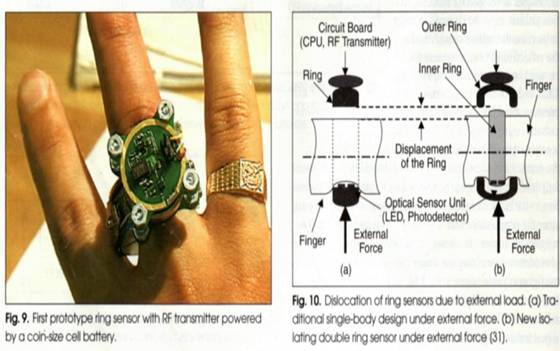





Published on Feb 14, 2025
Wearable sensors and systems have evolved to the point that they can be considered ready for clinical application. The use of wearable monitoring devices that allow continuous or intermittent monitoring of physiological signals is critical for the advancement of both the diagnosis as well as treatment of diseases.
Wearable systems are totally non-obtrusive devices that allow physicians to overcome the limitations of ambulatory technology and provide a response to the need for monitoring individuals over weeks or months.
They typically rely on wireless miniature sensors enclosed in patches or bandages or in items that can be worn, such as ring or shirt. The data sets recorded using these systems are then processed to detect events predictive of possible worsening of the patient's clinical situations or they are explored to access the impact of clinical interventions.
It is a pulse oximetry sensor that allows one to continuously monitor heart rate and oxygen saturation in a totally unobtrusive way. The device is shaped like a ring and thus it can be worn for long periods of time without any discomfort to the subject. The ring sensor is equipped with a low power transceiver that accomplishes bi-directional communication with a base station, and to upload date at any point in time.
Each time the heart muscle contracts,blood is ejected from the ventricles and a pulse of pressure is transmitted through the circulatory system.This pressure pulse when traveling through the vessels,causes vessel wall displacement which is measurable at various points.inorder to detect pulsatile blood volume changes by photoelectric method,photo conductors are used.normally photo resistors are used, for amplification purpose photo transistors are used.
Light is emitted by LED and transmitted through the artery and the resistance of photo resistor is determined by the amount of light reaching it.with each contraction of heart,blood is forced to the extremities and the amount of blood in the finger increases.it alters the optical density with the result that the light transmission through the finger reduces and the resistance of the photo resistor increases accordingly.
The photoresistor is connected as a part of voltage divider circuit and produces a voltage that varies with the amount of blood in the finger.This voltage that closely follows the pressure pulse.
It is a pulse oximetry sensor that allows one to continuously monitor heart rate and oxygen saturation in a totally unobtrusive way. The device is shaped like a ring and thus it can be worn for long periods of time without any discomfort to the subject. The ring sensor is equipped with a low power transceiver that accomplishes bi-directional communication with a base station, and to upload date at any point in time.
Each time the heart muscle contracts, blood is ejected from the ventricles and a pulse of pressure is transmitted through the circulatory system. This pressure pulse when traveling through the vessels, causes vessel wall displacement which is measurable at various points inorder to detect pulsatile blood volume changes by photoelectric method, photo conductors are used normally photo resistors are used, for amplification purpose photo transistors are used.
Light is emitted by LED and transmitted through the artery and the resistance of photo resistor is determined by the amount of light reaching it. with each contraction of heart, blood is forced to the extremities and the amount of blood in the finger increases. It alters the optical density with the result that the light transmission through the finger reduces and the resistance of the photo resistor increases accordingly. The photoresistor is connected as a part of voltage divider circuit and produces a voltage that varies with the amount of blood in the finger.This voltage that closely follows the pressure pulse
The LEDs and PD are placed on the flanks of the finger either reflective or transmittal type can be used. For avoiding motion disturbances quite stable transmittal method is used. Transmittal type has a powerful LED for transmitting light across the finger. This power consumption problem can be solved with a light modulation technique using high-speed devices. Instead of lighting the skiing continuously, the LED is turned ON only for a short time, say 10-100 ns, and the signal is sampled within this period, high frequency, low duty rate modulation is used for preventing skin-burning problem. The motion of the finger can be measure with an optical sensor. This motion detector can be used not only for monitoring the presence of motion but also for cencelling the noise. By using PD-B as a noise reference, a noise cencellation filter can be built to eliminate the noise of PD-A that completes with the noise references used. And adaptive noise cancellation method is used.
The noise-canceling filter combines two sensor signals; one is the main signal captured by PD-A and the other is the noise reference obtained by PD-B. The main signal mostly consists of the truce pulsate signal, but it does contain some noise. If we know the proportion of noise contained in the main signal, we can sensate the contained in the main signal, we can generate the noise of the same magnitude by attending the noise reference signal and then subtract the noise from the main signal to recover the true pulsatile signal.

The ring has a microcomputer performing all the device controls and low level signal processing including LED modulation, data acquisition, filtering, and bi-directional RF communication. The acquired waveforms sampled at 100Hz are transmitted to a cellular phone carried by the patient through an RF link of 105Kbps at a carrier frequency of 915 MHz. The cellular phone accesses a website for data storage and clinical diagnosis.
| Are you interested in this topic.Then mail to us immediately to get the full report.
email :- contactv2@gmail.com |